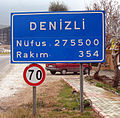Town sign
A town sign or city limit sign is a road sign placed at the side of the road or street at the boundary of the territory of a city, town, or village. Town signs may be placed for reading both by drivers entering the town and, in a different format, by those exiting it. Signs give the name of the town in the local official languages, and sometimes in other languages. In some countries, town signs are also an essential part of the traffic law, for example by defining (explicitly or implicitly) the speed limit within the town's territory.
By country
In some countries, such as Germany and Austria, signs aren't placed at the exact boundary of a city or town, but rather at the location where the settlement's built-up area (continuous string of buildings/development) begins and ends.
Austria
On September 6, 1994, Austrian lawyer Rudi Vouk (of Slovenian ancestry) drove faster than the speed limit of 50 kilometers per hour while driving through St. Kanzian, also known as Škocjan.[1] In the court case that followed, Vouk refused to pay the speeding ticket, arguing that the monolingual sign was unconstitutional.[1]
In December 2006, the Constitutional Court of Austria found that city limit signs had to be bilingual.[2] The facts of the case were that the district authority of Völkermarkt District had ordered signs for the city limits of Bleiburg, Ebersdorf, and Schwabegg to be put up only in German.[2] After this was found to be unconstitutional, the signs were also put up in Slovenian, but smaller; the court found that this too was unconstitutional.[2]
As of 2010, the issue of bilingual city signs in Austria has not been resolved.[1]
United Kingdom
In the United Kingdom, town sign may refer to a prominent, decorative, often carved sign, commemorating the values and history of the town. Synonymous with Village sign; Commonly in the centre of the town.
United States
In much of the United States, there is a similar county sign at the boundary between each county (or independent city not part of one), indicating the county being entered and often the one being left. Even if not done within a given U.S. state, there is also nearly always a welcome sign at the state line on every major highway, and most any other road. The welcome signs on Interstate highways are usually very large and have graphics, and may have an attached text-only sign directing motorists to the welcome center at a rest area. On smaller roads, they are usually more similar to town signs, showing the state and county, often with other signs indicating speed limit, a state law (such as "burn headlights during rain"), and/or a change in time zone.
In popular culture
In the film It's a Wonderful Life, directed by Frank Capra, a town-limit sign reading "You are now in Bedford Falls" appears. However, the pronoun "you" is deliberately left ambiguous.[3]: 16
Gallery
- Cast aluminium welcome sign for Congleton, UK by Leander Architectural
- Sign in Japan
- Entry sign, Chłopków, Poland
- Sign in the Canadian province of Québec
- Vlotho in the district of Herford, Germany
- Bilingual entry signs in German and Upper Sorbian in Upper Lusatia, Germany
- Bilingual English-Welsh sign with speed limit, Llechryd
- One of Catskill Park's brown and yellow town signs, showing the hamlet of Pine Hill, New York, United States
- Entry sign for Stafford, Texas on FM 1092
- Sign in Turkey
- Sign in South Africa
- Sign in Kazakhstan
- Bilingual entry signs in Beregszász / Berehove / Берегово (Ukraine) - with Cyrillic letters (for Ukrainian), Hungarian letters (for Hungarians) and rovas letters (for 12th-century Magyars)
- Bilingual entry sign in Polish and German in Upper Silesia, Poland
- Bilingual exit sign in Czech and Polish in Trans-Olza, Czech Republic
- Entry sign in Hradiště Military Training Area, Karlovy Vary Region, Czech Republic
- The speed limit of 50 km/h in Bambrugge
- A town area sign (with the speed limit of 40 km/h) in Vimpeli, Finland
- Entry sign in Damwâld, Netherlands
- Entry sign in Zaitseve, Ukraine
References
- ^ a b c Ketteman, Matthias C. (2010). "How to Implement Controversial Court Decisions: International Constitutional Lessons from Brown v. Board of Education for the Austrian Cases on Topographical Signs in Carinthia". Vienna Online Journal on International Constitutional Law. 4 (4): 590–623 – via heinonline.org.
- ^ a b c Klingenbrunner, Alexander (13 December 2006). "Bilingual Topography: Differences between German and Slovenian Place Names In Size are Unconstitutional". Vienna Online Journal on International Constitutional Law. 2 (2): 146–148 – via heinonline.org.
- ^ Bal, Mieke (2004). Narrative Theory: Political narratology. Taylor & Francis. ISBN 978-0-415-31660-6.
























